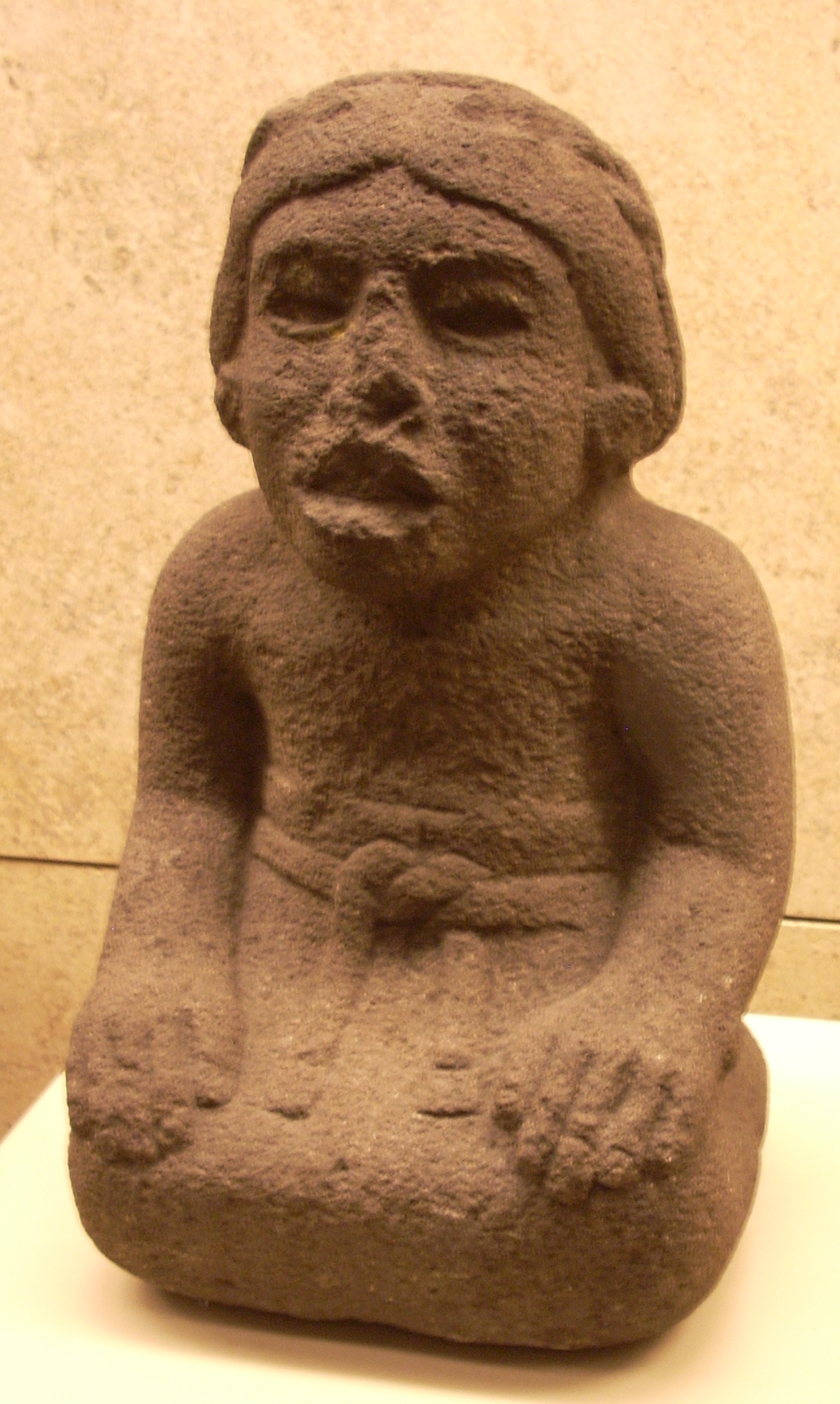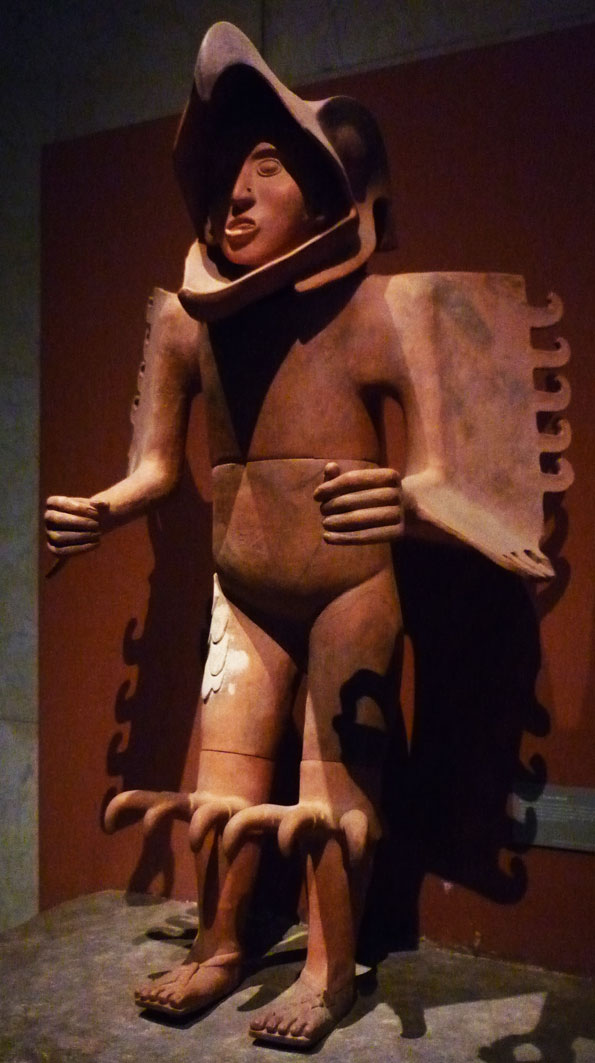|
Mācēhualtin
The mācēhualtin ( IPA: , singular ''mācēhualli'' ) were the commoner social class in Aztec society. The Aztec social class of the ''mācēhualtin'' were rural farmers, forming the majority of the commoners in the Aztec Empire. The ''mācēhualtin'' worked lands that belonged to the social unit of the calpolli called chinampas, with each family maintaining rights to the land so long as it did not lie fallow for more than two years. Within these lands, the rural ''mācēhualtin'' constructed small dams and terraces to increase their agricultural yield. Crops common to Mexican agriculture were grown on these plots, including maize, beans and squash. These projects were probably organized by the local communities and were not state led. From their produce and productivity, the corn were required to pay tribute to the Aztec nobility. During the reign of Moctezuma II (1502–1520), they were banned from serving in the royal palaces, as this monarch widened the divide between ''p ... [...More Info...] [...Related Items...] OR: [Wikipedia] [Google] [Baidu] |
Pipiltin
The Pipiltin (sg. ''pilli'') were the noble social class in the Mexica Empire. They are the lowest nobles in the civilization's social structure and above the commoners who achieved noble status due to an outstanding deed in war. These people were members of the hereditary nobility and occupied positions in the government as ambassadors and ministers, the army and the priesthood. Pipiltin often headed their own noble houses, called tecalli, with their own lands and dependent labourers. The subclasses within the ''Pipiltin'' were: tlahtohcapilli (a tlahtoani's son), tecpilli or teucpilli (a teuctli's son), tlazohpilli (son of a legitimate wife), and calpanpilli (son of a concubine). Children of the ''Pipiltin'' were given extensive education in preparation for the role they would play in their adult life. They were sent to the '' calmecac'', which was the center for higher learning, to study the ancient wisdom as well as "elegant forms of speech, ancient hymns, poems and histo ... [...More Info...] [...Related Items...] OR: [Wikipedia] [Google] [Baidu] |
International Phonetic Alphabet
The International Phonetic Alphabet (IPA) is an alphabetic system of phonetic notation based primarily on the Latin script. It was devised by the International Phonetic Association in the late 19th century as a standard written representation for the sounds of speech. The IPA is used by linguists, lexicography, lexicographers, foreign language students and teachers, speech–language pathology, speech–language pathologists, singers, actors, constructed language creators, and translators. The IPA is designed to represent those qualities of speech that are part of lexical item, lexical (and, to a limited extent, prosodic) sounds in oral language: phone (phonetics), phones, Intonation (linguistics), intonation and the separation of syllables. To represent additional qualities of speechsuch as tooth wikt:gnash, gnashing, lisping, and sounds made with a cleft lip and cleft palate, cleft palatean extensions to the International Phonetic Alphabet, extended set of symbols may be used ... [...More Info...] [...Related Items...] OR: [Wikipedia] [Google] [Baidu] |
Social Mobility
Social mobility is the movement of individuals, families, households or other categories of people within or between social strata in a society. It is a change in social status relative to one's current social location within a given society. This movement occurs between layers or tiers in an open system of social stratification. Open stratification systems are those in which at least some value is given to achieved status characteristics in a society. The movement can be in a ''downward'' or ''upward'' direction. Markers for social mobility such as education and class, are used to predict, discuss and learn more about an individual or a group's mobility in society. Typology Mobility is most often quantitatively measured in terms of change in economic mobility such as changes in income or wealth. Occupation is another measure used in researching mobility which usually involves both quantitative and qualitative analysis of data, but other studies may concentrate on soci ... [...More Info...] [...Related Items...] OR: [Wikipedia] [Google] [Baidu] |
University Of California Press
The University of California Press, otherwise known as UC Press, is a publishing house associated with the University of California that engages in academic publishing. It was founded in 1893 to publish scholarly and scientific works by faculty of the University of California, established 25 years earlier in 1868. As the publishing arm of the University of California system, the press publishes over 250 new books and almost four dozen multi-issue journals annually, in the humanities, social sciences, and natural sciences, and maintains approximately 4,000 book titles in print. It is also the digital publisher of Collabra and Luminos open access (OA) initiatives. The press has its administrative office in downtown Oakland, California, an editorial branch office in Los Angeles, and a sales office in New York City, New York, and distributes through marketing offices in Great Britain, Asia, Australia, and Latin America. A Board consisting of senior officers of the University of Cali ... [...More Info...] [...Related Items...] OR: [Wikipedia] [Google] [Baidu] |
University Of Oklahoma Press
The University of Oklahoma Press (OU Press) is the publishing arm of the University of Oklahoma. Founded in 1929 by the fifth president of the University of Oklahoma, William Bennett Bizzell, it was the first university press to be established in the American Southwest. The OU Press is one of the leading presses in the region, and is primarily known for its titles on the American West and Native Americans. OU Press also publishes books on topics ranging from animals to ancient languages.Oklahoma Historical Society's Encyclopaedia of Oklahoma History and Culture Tornadoes and severe weather Severe weather is any dangerous meteorological phenomenon with the potential to cause damage, serious social disruption, or loss of human life. These vary depending on the latitude, altitude, topography, and atmospheric conditions. High ... are another focus. The press releases around 80 books every year. A profile of the University of Oklahoma Press from 2018 quotes OU Preside ... [...More Info...] [...Related Items...] OR: [Wikipedia] [Google] [Baidu] |
New Spain
New Spain, officially the Viceroyalty of New Spain ( ; Nahuatl: ''Yankwik Kaxtillan Birreiyotl''), originally the Kingdom of New Spain, was an integral territorial entity of the Spanish Empire, established by Habsburg Spain. It was one of several domains established during the Spanish colonization of the Americas, Spanish conquest of the Americas, and had its capital in Mexico City. Its jurisdiction comprised a large area of the southern and western portions of North America, mainly what became Mexico and the Southwestern United States, but also California, Florida and Louisiana (New Spain), Louisiana; Central America as Mexico, the Caribbean like Hispaniola and Martinique, Martinica, and northern parts of South America, even Colombia; several Pacific archipelagos, including the Philippines and Guam. Additional Asian colonies included "Spanish Formosa", on the island of Taiwan. After the 1521 Spanish conquest of the Aztec Empire, conqueror Hernán Cortés named the territory New S ... [...More Info...] [...Related Items...] OR: [Wikipedia] [Google] [Baidu] |
Nahuatl
Nahuatl ( ; ), Aztec, or Mexicano is a language or, by some definitions, a group of languages of the Uto-Aztecan language family. Varieties of Nahuatl are spoken by about Nahuas, most of whom live mainly in Central Mexico and have smaller populations Nahuatl language in the United States, in the United States. Nahuatl has been spoken in central Mexico since at least the seventh century CE. It was the language of the Mexica, who dominated what is now central Mexico during the Late Postclassic period of Mesoamerican chronology, Mesoamerican history. During the centuries preceding the Spanish conquest of the Aztec Empire, the Aztecs had expanded to incorporate a large part of central Mexico. Their influence caused the variety of Nahuatl spoken by the residents of Tenochtitlan to become a prestige language in Mesoamerica. Following the Spanish conquest, Spanish colonists and missionaries introduced the Latin script, and Nahuatl became a literary language. Many chronicles, gram ... [...More Info...] [...Related Items...] OR: [Wikipedia] [Google] [Baidu] |
Spanish Conquest Of Mexico
The Spanish conquest of the Aztec Empire was a pivotal event in the history of the Americas, marked by the collision of the Aztec Triple Alliance and the Spanish Empire. Taking place between 1519 and 1521, this event saw the Spanish conquistador Hernán Cortés, and his small army of European soldiers and numerous indigenous allies, overthrowing one of the most powerful empires in Mesoamerica. Led by the Aztec ruler Moctezuma II, the Aztec Empire had established dominance over central Mexico through military conquest and intricate alliances. Because the Aztec Empire ruled via hegemonic control by maintaining local leadership and relying on the psychological perception of Aztec power — backed by military force — the Aztecs normally kept subordinate rulers compliant. This was an inherently unstable system of governance, as this situation could change with any alteration in the status quo. A combination of factors including superior weaponry, strategic alliances with oppresse ... [...More Info...] [...Related Items...] OR: [Wikipedia] [Google] [Baidu] |
Women In Aztec Civilization
Women in Aztec civilization shared some equal opportunities. Aztec civilization saw the rise of a military culture that was closed off to women and made their role more prescribed to domestic and reproductive labor and less equal. The status of Aztec women in society was further altered in the 16th century, when Spanish conquest forced European norms onto the indigenous culture. However, many pre-Columbian norms survived and their legacy still remains. History The status of Aztec women has changed throughout the history of the civilization. In the early days of the Aztecs, before they settled in Tenochtitlan, women owned property and had roughly equal legal and economic rights. As an emphasis on warfare increased, so too did ideas of male dominance. Women did not participate in warfare except as prisoners. Marriage Aztec marriage practices were similar to those of other Mesoamerican civilizations such as the Maya. Aztecs married at a later age, during their late teens and earl ... [...More Info...] [...Related Items...] OR: [Wikipedia] [Google] [Baidu] |
Aztec Warfare
Aztec warfare concerns the aspects associated with the military conventions, forces, weaponry and strategic expansions conducted by the Mesoamerican chronology, Late Postclassic Aztec civilizations of Mesoamerica, including particularly the military history of the Aztec Triple Alliance involving the city-states of Tenochtitlan, Texcoco (Aztec site), Texcoco, Tlacopan and other allied polity, polities of the central Mexican region. This united the Mexica, Apulteca, and Chichimeca people through marriages. The Aztec armed forces were typically made up of a large number of commoners (''yāōquīzqueh'' , "those who have gone to war") who possessed extensive military training, and a smaller but still considerable number of highly professional warriors belonging to the nobility (''Pipiltin, pīpiltin'' ) and who were organized into warrior societies and ranked according to their achievements. The Aztec state's primary purpose was political expansion and dominance of and exaction of tri ... [...More Info...] [...Related Items...] OR: [Wikipedia] [Google] [Baidu] |
Tēlpochcalli
Tēlpochcalli (, Nahuatl: ''house of the young men''), were centers where Aztec youth were educated, from age 15, to serve their community and for war. These youth schools were located in each district or ''calpulli''. Life in the telpochcalli Life in the ''telpochcalli'' was tough. From early morning strenuous activities began. The day began with a cold bath, followed by a controlled and extremely frugal meal. They had to memorize the songs which they offered as praises of their gods and practiced in the use of weapons such as the sling, and the ''macuahuitl''. Students had other obligations, such as carrying the necessary materials to repair the temples (''teocalli''), and collectively working the fields for their livelihood. The Aztec world was characterized by the care the rulers put into the education system. Tenochtitlan schools were of two types, generally depending on the boys' social background: the sons of nobles attended the ''calmecac'', an institution that was located ... [...More Info...] [...Related Items...] OR: [Wikipedia] [Google] [Baidu] |



